#outsiders script - 1983
Explore tagged Tumblr posts
Text
Obligatory disclaimer that obviously Dally harassing Cherry is very serious and shouldn’t be excused or romanticised or downplayed.
That being said, it’s kind of hilarious how much of a dork he is about it, in every adaptation.
Book!Dallas: harasses Cherry….then buys her a coke. Then asks her out the next time he sees her.
Movie!Dallas: harasses Cherry…..then falls off his chair, causing her to laugh in his face. Then buys her a coke and asks her out the next time he sees her.
Musical!Dallas: harasses Cherry…..by info dumping about cicadas. Then buys her a coke.
#we don’t talk about this enough#the side of Dallas Winston that’s kind of a dork#but I’m glad that every adaptation finds a way to hint at it just a bit#yes I know falling off his chair was a blooper they kept in#but the dialogue where he’s practically twirling his hair over how she told him to go to hell was in the script#the outsiders#the outsiders book#the outsiders 1983#the outsiders musical#dallas winston#cherry valance
182 notes
·
View notes
Text
Full movie cast description
Still reading the script, or finally starting and I wanted to share the full of these descriptions. Not just because it was really funny that Randy just exists but, also that apparently the movie always struggled with Dally’s age. He isn’t listed and in marketing material it’s not listed or he’s made older than he is in the book/movie (still 17)


#outsiders script - 1983#<- this’ll be my tag for sharing neat stuff - follow or blog tag as you see#do love how it is book descriptions essentially but Tom and Emilio are NOT tall 💀#the outsiders#outsiders#outsiders 1983#ponyboy curtis#sodapop curtis#darry curtis#darrel curtis jr#steve randle#twobit mathews#dallas winston#johnny cade#outsiders novel
119 notes
·
View notes
Text

How I feel when I show up to a stage combat class
#the outsiders#ponyboy curtis#ponyboy#darry curtis#johnny cade#the outsiders musical#dallas winston#the outsiders 1983#steve randle#two bit mathews#the outsiders sodapop#sodapop curtis#darry#steve the outsiders#two bit the outsiders#was told my outfit was “outsiders core” when i went so i pulled out the outsiders musical script i had just gotten printed that day
97 notes
·
View notes
Text
let's be honest for a sec did anyone actually watch the outsiders TV series because I genuinely don't trust it
#i once was reading the descriptions of each episode and the one was saying that soda got a girl pregnant so i was immediately like WHAAAT#hinton didn't participate in the script writing so I'm not really sure if it's even worth it#though i don't trust hinton either#it's just ain't the same without johnny n dally#the outsiders#dallas winston#the outsiders 1983#johnny cade#ponyboy curtis#se hinton#the outsiders TV show#nickyapping
83 notes
·
View notes
Text
the big theorypost. spoilers for both volumes of misericorde
maybe this goes without saying, maybe not: i think tatiana is A Catherine. firstly, because of the law of conservation of mystery women*. but also she describes herself as a dilettante, and is clearly a matched set with he/him eustace (2stace). they're actually labeled as eustace2 and her2 in the script. eustace and catherine, of course, were unexpectedly close and worked together in the library. which is relevant because...
tatiana and 2stace are on some reality warping storyteller shit. this is pretty clear from their conversation, i think. the most obvious example of it in action is that tatiana describes the IRA-assassination-plot thriller to alex, who then finds herself inside it. alex's narration talks about going along with jim because it "feels right", which is plausibly not mind control, except tatiana also becomes an old friend and/or boss of everyone else she meets.
are tatiana and 2stace the *same people* as catherine and eustace, or versions of them? at first i thought alex was A Flora and jim was A [The Farmer] but that doesn't seem as one-to-one. in 1983 they're both immediately off-putting, whereas in 1483 eustace is capable of acting normal-ish, but maybe it was just 500 years of existing outside the narrative??
evidence for 1483 eustace and catherine having reality-altering powers and/or being aware of the narrative: the shelves. eustace's references to things she can't explain. catherine having visions of music/poetry/social movements/things they Need To Do. the presence or absence of goats. catherine's chronicles are mentioned but not there; meanwhile eustace chronicles darcy's visions, which include Books and Fire Goat, and won't let anyone see them.
There Are Two Swords. 2stace and tatiana are philosophically opposed. eustace (1483) talks about preferring not to interfere with people, 2stace (1983) is a stickler for accuracy, mad about liberties taken with katherine's (in nunleft) and jim's (in prosopography) stories. meanwhile tatiana loves spoilers, mocks 2stace for not being able to enjoy his own fantasies, and "loathe[s] the tyranny of continuity."
so i guess my reach-iest theory is that eustace and catherine, in 1483, are both to some extent able to alter the story / the reality they are in, and approach it differently. eustace is not interfering, whereas catherine is flitting around trying to bring out the hidden potential of the nuns and (checks notes) trying to kill someone and change the course of history? i don't know enough about the war of the roses for this.
what catherine was doing "got her killed," but eustace also refers to james as a "solution to a problem i let get out of hand". eustace could have been involved (metafictionally??) without actually doing the deed.
in fact one of the swords killed catherine and the other is wielded by the demon.
so.. maybe... catherine is killed, but still present, possibly involved in the ghost sightings that *aren't* eustace (and it would be thematically appropriate for her demon to be a magic terror while eustace's is created by dressing up in armor) and the magic circles. either she or eustace is the devil james saw (who spoke with a woman's voice). eustace is trying to keep the story on track and struggling with hedwig, but hedwig isn't her real enemy. (has hedwig stepped into a role somehow by picking up catherine's job? or is she just totally mundane and lost. poor thing.)
but also this sounds crazy so WHO KNOWS.
P.S. it's so goddamn funny that tatiana asks alex about 15th century metallurgy. girl are you trying to catch your stickler friend in an inaccuracy? cinemasins ding?
*umineko has never followed the law of conservation of mystery women, ever, except in the ways that it does
25 notes
·
View notes
Text
I want to talk about the Teen Wolf siblings, particularly their age differences.
Brett is a freshman in season 4. We don’t know how old Lori is, but later she says Brett only accepted the scholarship at Devenford if they would accept her as well. This means either Devenford includes some middle school as well as high school, Lori was smart enough to skip a grade or two, Brett and Lori are 9 months apart, or they’re twins. It’s also possible she’s a couple years younger and was only recently accepted, but since he bargained for her from the beginning, I don’t think it’s as likely.
Based on the short audio clips from “Motel California” it sounds like Boyd and Alicia were close in age, both pretty young, but when we see her body she looks a little older. I would assume he’s older since he was in charge of watching her.
Malia and Kylie were close in age based on the framed photo in her room. In “Ghosted” Kylie has mysteriously aged from about 7 to about 12. Though this is likely due to forgetting information and not caring enough to fact check their own work.
The same could be said for Theo and Tara. They seem to be close in age, but the actresses playing Tara look like different ages. I would guess in season 5 flashbacks she was 11 or 12 when Theo was 9, but in season 6 she looks 17.
Isaac is 16 in season 2 and Camden would have been 24. There is a discrepency unless I’m missing something. Since season 2 is early in the year I’m willing to bet Camden would be 25 later in the year. If Isaac is 16 and Camden would be 24, that’s an 8 year gap. But if he graduated in 2006, he was born in 1988 and is approximately 6 years older. There’s no concrete evidence of when either of their birthdays are, so perhaps Isaac’s birthday is before Camden’s and there’s a short period of time the gap is 7 years. The calendar puts his birthday in February.
Kate said that growing up Chris always tried to make her look like the bad guy. In 3B Chris says he was 18-years-old 24 years ago putting Chris’s birth year about 1969. Kate was born in 1983. That is a 14 year gap. Either she exaggerated or lied, which I would believe, or Chris was an incredibly shitty brother, which I would also believe. Could you imagine 17 year old Chris blaming 3 year old Kate for him coming home late one night or breaking their mom’s favorite vase?
We don’t know how old Gerard is. Alexander was 27 when he died. Alexander was 19/20 years older than Chris, so Gerard was probably in his early to mid twenties when Chris was born. A lot of actors’ ages coincide with their character’s approximate age. Michael Hogan was born in 1949, so if Gerard is around his age, he’s 20 years older than Chris and 34 years older than Kate. But then he would one year older than Alexander. Not impossible, but he is likely older.
Hayden is about 16 in season 5 because she can drive. The youngest a cop can be is 20, so at the very least Clark is 4 years older. It sounds like Clark had been her guardian for a while, so the gap is likely larger.
If we are going to believe the “In Memorium” video from MTV, Laura was born in 1982 and Peter was born in 1976. We never actually know how old Derek is. Jeff said his ID, putting his birthday in November 1988, was fake, but why? What is the significance of it being fake? It served no purpose and I think Jeff just wanted to fuck with us. Especially because it’s not canon in the show, he said it outside of the show. And if we believe the calendar that makes Derek a Christmas baby, why would he make himself only a month and a half older?
I’m going to assume Derek was “with” Kate leading up closely to the fire, meaning late 2004. If Derek was 16, or almost 16 if his birthday is Christmas, that would put his birthday in 1988. So in the pilot he’s 22. In the script he was meant to be 19 but then he was aged up because Jeff thought it was more important to traumatize him than find a way around it. In 3A Cora says she’s 17, which would put them at a 5 year gap. Laura is 6 years older than Derek and 11 years older than Cora. And if Cora was 11 by January of 2005, she was born in 1993.
I don’t know if this is canon or fanon that Talia raised Peter. Regardless, he is about 5 years older than Laura, 12 years older than Derek, and 17 years older than Cora. But Talia would have to be at the youngest 8 years older than Peter, and that’s if she had Laura at 13. In “Visionary” she appears to be about mid-forties. If this is within a year of the fire, then Peter is 26/27. The gap between Peter and Talia could range from 8 to 20 years.
I’m just so interested in these dynamics.
#teen wolf#teen wolf meta#derek hale#peter hale#cora hale#talia hale#chris argent#kate argent#brett talbot#lori rohr#lori talbot#vernon boyd#gerard argent#hayden romero#valerie clark#isaac lahey#malia tate#theo raeken#i want to know how many of the younger siblings were accidents#or maybe the older ones
176 notes
·
View notes
Note
hi! I was rewatching 2x09 and there's a detail I can't figure out about the very last shot (the one where the camera spins to show us the UD version of the gym from the outside.) Some of the lights from the ball inside are lit, but s4 confirmed it's possible for light sources (or at least their glow) in the UD to 'sync' when turned on in the right side up, even if they were not there or didn't exist in 11/6/83. So far so good, but what about the cars in the parking lot from december (13/15/18th? I can't see the poster) being in the exact same position in the UD?
I took some ss but i'm not sure if you can see the cars that clearly
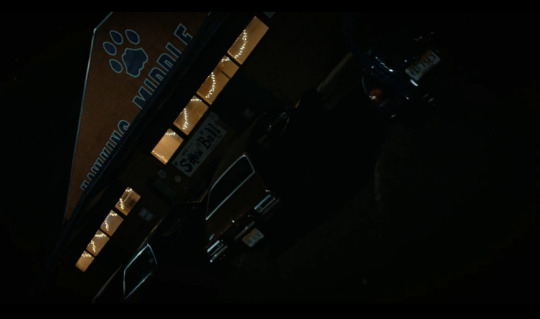
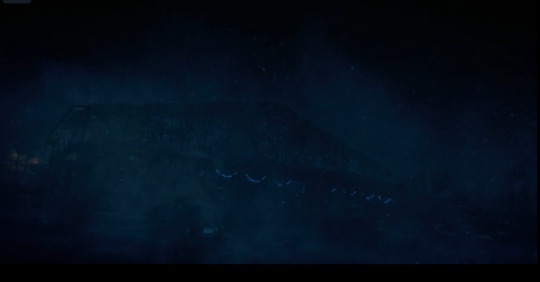
Ig it could depend on whether the (blue) UD is a snapshot of the right side up or if it's will's headspace here, so idk.
Interesting find here!
I think it's entirely possible that different aspects of the UD are stuck at different times.
When Will vanished, he caused time to be stuck in Nov 6, 1983 (likely at 8:15 just like "Little Boy" the atomic bomb did to time pieces in Hiroshima...)
It seems like when a gate opens- time freezes. And whenever gates open, it seems like it's due to a (metaphorical) nuclear reaction.
When Will vanishes, "nuclear fission" occurs (just like "Little Boy" post about that comparison here). Nuclear fission = splitting (atoms) = releases a large amount of energy (+ toxic nuclear waste) = opens a gate. I talk about that in this post.
When Vecna and the MF target their victims, "nuclear fusion" occurs.
Nuclear fusion = fusing (atoms) together. Vecna/MF "combines" with their victims (they "join" him) = releasing a large amount of energy (no toxic waste!) = opens a gate.
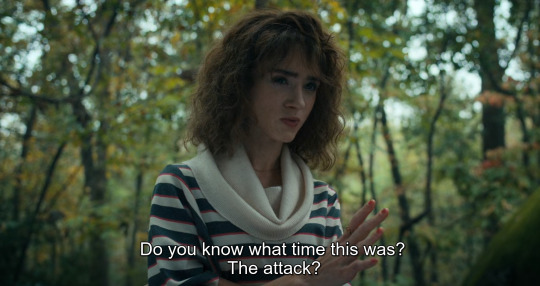
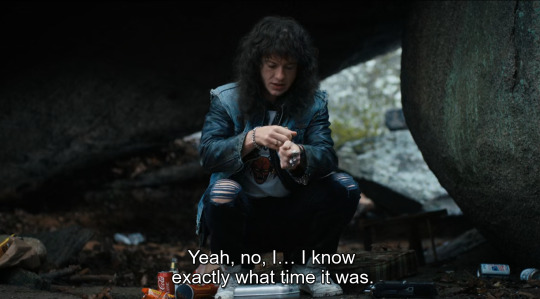
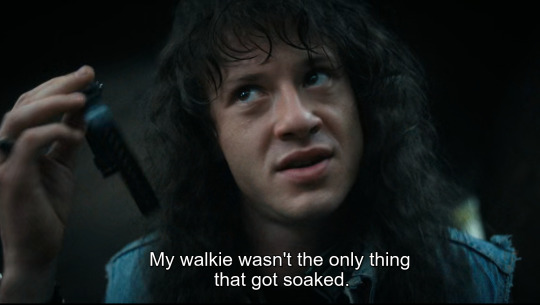
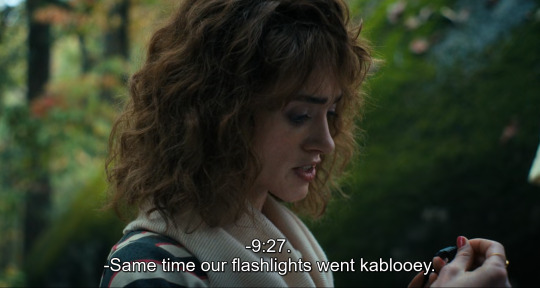
(Credit to @willbyersabyss for this find).
This also occurred with the MF in ST3 during the movie theatre scene. That scene showed the MF "combining" with the rats while Will appears triggered while on a "movie date" with Mike. More "nuclear fusion".
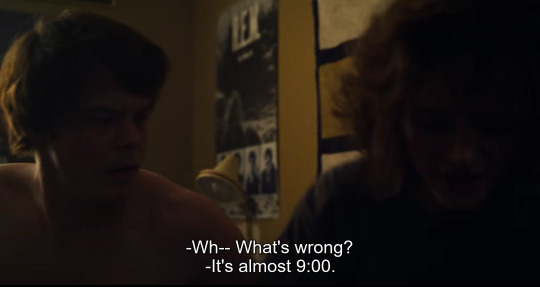
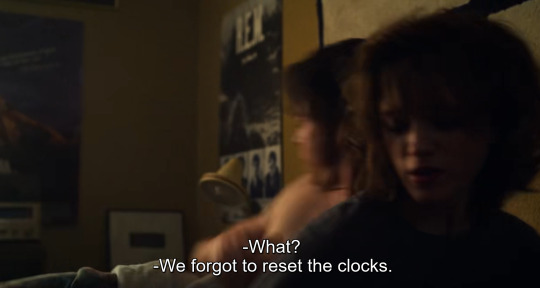
(Credit to @threemanoperation for this find).
This occurs yet AGAIN in ST3 while the MF is again fusing with its victims.
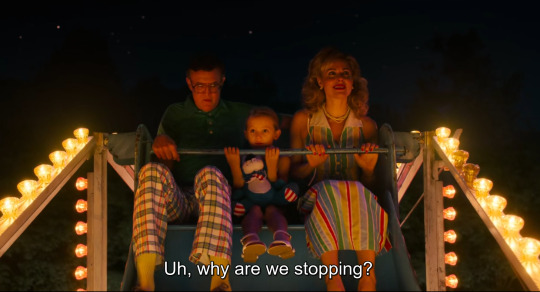
MF fuses with its victims = fireworks go off (release of energy) and time stops (represented as the Ferris Wheel(er) stopping).
So basically, when a gate opens it requires a lot of energy. Nuclear reactions release a lot of energy. And as we know from Hiroshima, a nuclear reaction can essentially "freeze time" by stopping time pieces (like a watch) from functioning. Thus they are using this as a metaphor here.
As for the snowball scene, could it be possible that a gate was opening up at that specific time? Yes it could be. Lets think of the possible narrative reason, the supernatural reason and the symbolic one:
We learn in ST3 that the Russians have been working on opening a gate in Hawkins for a while now.
We don't really see much of Will after he dances with that girl, but we do know from the original script that he looks over (longingly) at Mike.
The Snow Ball... "he likes it cold", feeling forced to dance with a girl... "Every Breath You Take" plays (a song about an abusive stalking ex...) We can make the assumption that Will may have been triggered again at that dance. When I say "triggered" I mean this on two levels: 1. Supernatural stuff arising again. 2. Memories of Will's father resurfacing.
I hope I'm making sense!
And yes... I did do some research on nuclear physics for this theory...
7 notes
·
View notes
Note
Are the events of "Doctor Horrible's Sing-Along Blog" canon in the Bronze Realms?
At the very least not as-presented. I won't say that Doctor Horrible definitely exists in the BronzeRealms by default, but, I will say that, if he does, if that's a DLC module you decide to slot into the mainstream continuity, I know exactly where and how he fits into it. And it's not in 2008. Despite breaking the title and the framing device, it's in 1983. "Doctor Horrible's Sing-Along Home Videos", if you will.
The reason for this change is a little idea I'm shamelessly stealing from my headmate Alex called "Megamind Vs Doctor Horrible". Megamind is mainstream BronzeRealms, and if Doctor Horrible exists, it's as his foil.
The rest of this post will contain full spoilers for both Doctor Horrible's Sing Along Blog, and more importantly, Megamind. For real, person who I know is still reading this post and hasn't watched Megamind yet, yes you, DO NOT click further into this post, or read the comments, tags, or reblogs. I know it's an old movie, but if you can, Megamind is worth watching fresh.
...Are they gone? We've all seen the movie now, right? Right?
Okay. Let's start by saying that anything written in orange is optional to the Doctor Horrible Expansion Content. Make sense? (Might need a better rule if this kind of distinction comes up more often in future posts...)
The Evil League of Evil doesn't exist, but the Injustice Society does. Bad Horse, even from the young adulthood (for a horse) of 6 years, quickly becomes a powerful and leading figure in the Injustice Society alongside Icicle Senior in the 1950s. Bad Horse takes the reigns on their recruitment outreach programs, researching and evaluating lesser supervillains to see who has the potential to step up with a little boost of resources.
In 1983, Doctor Horrible earns his place in the Injustice Society when he murders a local environmental protester, depowers the beloved hero Captain Hammer, and conquers about one fifth of LA to rule according to his bidding.
Now, over in Metro City, "superhero" and "supervillain" don't mean the same thing that they do in any other city. Local culture dictates that a "supervillain" (as opposed to just a villain) is a registered member of the Doom Syndicate. This isn't a team, at least not usually. It's a loose coalition of "supervillains" who have agreed to a series of restrictions and terms regarding what kinds of crimes they can commit, what collateral damage is acceptable, standards of behavior, family-friendly language, what kinds of insults are off the table, what ideologies or political stances they can't express openly... They've agreed to keep their own schemes eminently low-stakes, no matter how spectacular they might become to witness. Even if a Doom Syndicate member conquers the city, they've agreed to a certain standard of fair treatment for their subjects and a charter for how they are and aren't allowed to respond or interfere when the citizens rise up against them. And once their schemes are foiled, they have to help clean up the mess and repair the city too.
In exchange, Doom Syndicate supervillains get reduced sentencing, nicer prison cells while they're in them (The "special containment unit" serves waffles on Wednesday), won't get shot at by the police when they're not in obviously bulletproof armor or vehicles, and Metro City will not contact outside authorities or accept help from outside superheroes in stopping them.
In essence, superhero fights in Metro City are for show. It's less scripted than Pro Wrestling, but otherwise very similar. Everyone is playing to the audience and tv cameras. Everyone wants to win, sure, but they're also willing to take a dive if it'll be cool or narratively dramatic. Sure, your school or workplace might get smashed to dust sometimes, but it'll be back up in a few days, thanks to Doom Syndicate. Maybe you'll even get to throw a dislodged pipe at someone's helmet to distract them while the hero sneaks up. That sounds fun. It's all in good faith. Long story short, no-one has ever died, not even once, during an official Doom Syndicate-sanctioned supervillain scheme or the superhero fights that result from them.
That is, before 1985, when Doom Syndicate co-founder Megamind was seen apparently having murdered the superhero Metro Man.
Besides taking place in the 80s the rest of the movie plays out basically the same, with an added sprinkle of... well... Tighten isn't playing by the rules, and Megamind isn't used to real lives being on the line. But despite seeing himself primarily as a performer, Megamind steps up and saves his city, for real. So despite going back to the performance fights after that, for the first time Metro City also knows that they have a true hero who will protect them when it's seriously needed.
In 1990, the genetic Augment tyrant Anton York is elected President of the United States in a Leap Term election (a concept I know I will have to actually define eventually but not right now). The Eugenics War comes to America, and superheroes and supervillains alike, everywhere, are disappearing or being forced to retire under suspicious circumstances.
Doctor Horrible passes himself off as an Augment and betrays the Injustice Society for a position in the new rising power structure of the world, sending the other villains scattering. He catches and executes the aging Bad Horse himself to secure the trust of the Augments. He is given a regional oversight position over all of Southern California, including Metro City.
When new legislation passes that forces the Mayor's office to officially disband the Doom Syndicate, nothing really changes. People just keep playing by the rules, same as they always have, and the local authorities who are used to it just play along too and take it easy. Metro City has its own thing going on and they like it. Then Doctor Horrible comes to enforce the new order of things.
With a need for the city to perform for outsider eyes, Megamind pretends to flip again and cave to the Augment regime, and volunteers to rule the city on Doctor Horrible's behalf. This buys them time, just a year or two until Doctor Horrible notices something's wrong (or right) and comes back. But it's long enough to start preparations for Megamind's greatest scheme yet.
Megamind's plan is to surround Metro City in a giant force field, and launch it into space. Metro City will be safe from the Eugenics War. While he and Minion are keeping up appearances as the city dictators and getting the force field all set up and triple-tested to make sure it won't fail and suffocate everyone, Roxanne Ritchi is hush-hush organizing an underground to make sure that everyone is on the right side of that barrier when it goes up, giving anyone who doesn't want to be stuck in the city a chance to get out, and helping people smuggle their loved ones from different parts of the country in to be safe with them.
But both Megamind and Roxanne have a secondary scheme. Both of them are secretly planning to be on the outside of the force field when it goes up, so that they can move on to other cities and keep fighting the good fight.
They both tell Minion to stay behind and protect the other, and the city. Instead of telling the two of them that they're both planning the same protection-doublecross, Minion just does the same thing. He goes to find Music Man, and tells him that all three of them are going to be gone while the city is in space, and if anything threatens the city, it will be up to Music Man to step up and stop it, even if he only sees himself as a performer, just like Megamind once had.
So when Doctor Horrible does return and force their hand, and the force field goes up, trapping Doctor Horrible and the regime he works for out, and the city goes up, free and secure, Minion finds Megamind and Roxanne and reveals that none of them went up with it, because the three of them are a team.
Thankfully for Music Man being able to avoid a massive nervous breakdown for actually having life-and-death stakes on his shoulders for the first time, the one time someone tries to sabotage the force field, Megamind's fellow Doom Syndicate supervillains come together with some of the other lesser-known local performer-superheroes to stop it.
Meanwhile, on the outside, Megamind, Roxanne, and Minion are taking the fight elsewhere. To Doctor Horrible, to LA.
When they sneak into his lab, they're horrified to discover the corpse of a woman being preserved in a glass case hooked up to some contraption. Someone named Penny. Megamind figures out the machine is meant to resurrect her, reversing the specific radiological effects of Doctor Horrible's Death Ray (the physical injuries having been surgically repaired by LA's best doctors years ago)... but it won't work.
Megamind is hella autistic and ditzy, and fixes an equation on the whiteboard before they leave without thinking about it. So when Doctor Horrible returns to his lab, he's able to activate the machine. He resurrects Penny. At first she's thankful, and when Roxanne approaches her and offers to sneak her out, she turns it down.
But this time he has the confidence to actually talk to her. She sees his LA. She hears about what he did to Captain Hammer, to the Injustice Society, to Bad Horse, what he's done for Anton York, and what he plans to do once he can get the upper hand on these superiors too.
She murders him. Stabs him, with a fork, and doesn't stop.
Megamind, Roxanne, Minion, and Penny, who they help to escape and take on a new identity, all survive the Eugenics War, to the end. There's another whole story about how after the war ended in 1998 they got Metro City back down to earth, but for now I'll leave it said that they did, all safe and sound, and Megamind happily returned to his performances, his city, his people. And most villains, the ones who don't play by the rules, still know better now than to come to Metro City. It might be all fun and games when you leave them alone, but that doesn't make it easy pickings. After all, no-one ever figured out what happened to Doctor Horrible...
#BronzeRealms#BronzeRealms DLC Modules#BronzeRealms Eugenics War#megamind spoilers#Doctor Horrible's Sing-Along Blog#megamind#superheroes#supervillains#villains vs villains#supervillains with a code#superheroes as entertainment#roxanne ritchi#Roxanne was Lois Lane's journalistic inspiration (and bisexual awakening) who she had a big poster of#(like Vicki Vale was for her in My Adventures With Superman)#in the version without Doctor Horrible the Augment representative they were tricking/counterscheming was Machiavillain#Penny moved to Philadelphia since there's hardly any superhero/supervillain activity there#she sleeps with a dehydrated shark cube she swiped from Megamind under her pillow and a glass of water on the nightstand#captain hammer#Captain Hammer became a Sokovia Accords advocate and an antivaxxer (both groups are embarrassed to be associated with him)#he has however learned to treat women with real respect#Metro Man is still dead#not everyone has the stomach to be a superhero even if they have the powers#megamind vs the doom syndicate#megamind rules#dr horrible#dr horrible sing along blog
7 notes
·
View notes
Text
Propelled chiefly by last year’s London production, I have written a (rather) long form piece to do with Rebecca the Musical. Though focusing mainly on this eventual and heavily expectant premiere of the English production of the musical, discussion relates also to the original and other iterations of the show, and musicals more generally, too.
The piece is anchored by the central theme of insatiability while looking in turn at:
the process of tracing the evasive histories of character representations and theatrical productions over many decades – including also flickered and largely forgotten records of the play and opera forms of Rebecca, and the “apparitional”, equivocal lens that queer female sexuality is handled with across large spans of time
decoding evidence of sparse, if periodically rather dire, female queerness in theatrical, musical contexts – guided by the disciples of dykeish dissatisfaction in the musical’s character of Mrs Danvers or the story’s primary author of Daphne du Maurier herself
considering what it means to exist as an audience member responding in situ to (principally female) performers with thrilling voices, both in and outside an auditorium, and the delicate but frequently under-discussed predicament of queer female diva devotion.
Take a look if you're interested!
In further expansion of photographic documentation of each of the examined stage-based, theatrical iterations of Rebecca, more images are presented below.
Discussion originates from the existence of the 2023 English premiere production of Rebecca the Musical at the Charing Cross Theatre in London, where cast principals included Kara Lane as Mrs Danvers (alternated by Melanie Bright), Lauren Jones as I (the new Mrs de Winter), and Richard Carson as Maxim. Photos by myself.



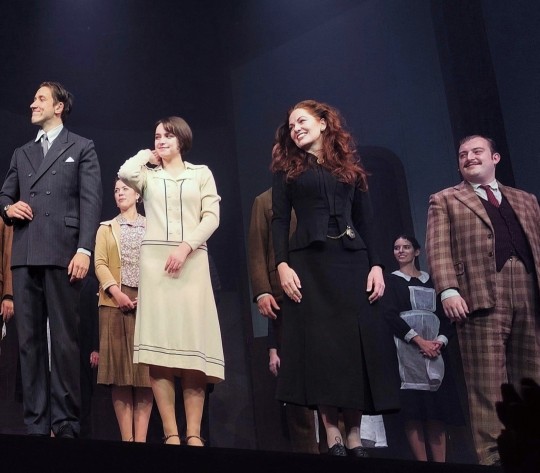
The first stage production of Rebecca arose much earlier, concerning the 1939 play by the same name at the Queen’s Theatre on Shaftesbury Avenue (now The Sondheim Theatre). Daphne du Maurier herself wrote its script. Margaret Rutherford played Mrs Danvers, Celia Johnson was the new Mrs de Winter, Owen Nares appeared as Maxim. The Queen’s Theatre was bombed in 1940 during WWII at the time of Rebecca’s occupancy, becoming the first theatre in London to be hit by a wartime bomb, and bringing to an immediate premature close the show’s successful run - and highlighting earlier associations of this story's connection to tumultuous tales and dramatic events in histories of it's staging, as the attempted primary stagings of the English musical iteration would later return to.
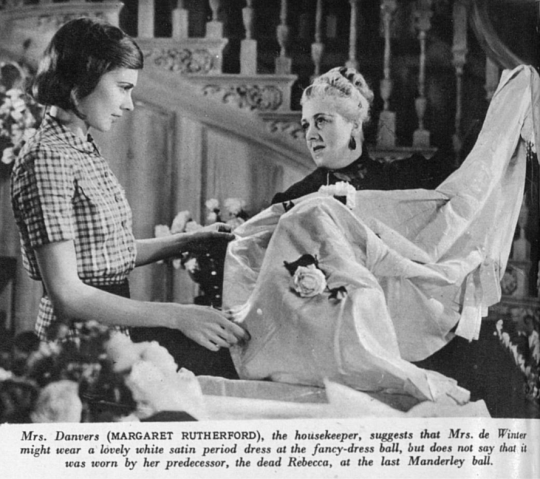



Photos from this first theatrical, London production include those by Angus McBean from a periodical spread entitled ‘Mystery and Murder in Stately Cornish Home - Dramatic Moments of Du Maurier’s “Rebecca.”’, published in The Sketch (vol. 190), May 1940.


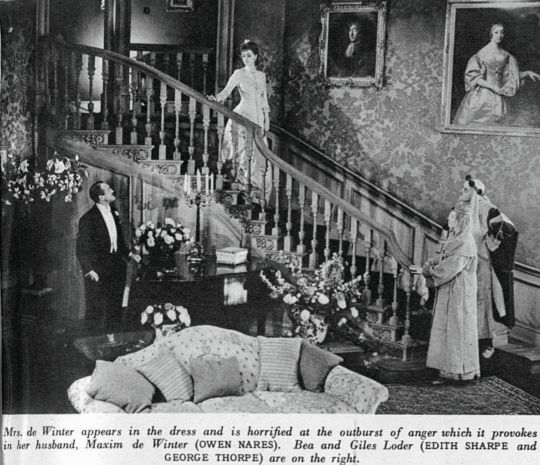

The play also then appeared on the road in America, and subsequently on Broadway in 1945 at the Ethel Barrymore Theatre for a fleeting 20 performances; and of this entity, record remains even more scarce. Cast principals included: Florence Reed (Mrs Danvers), Diana Barrymore (the new Mrs de Winter), Bramwell Fletcher (Maxim).
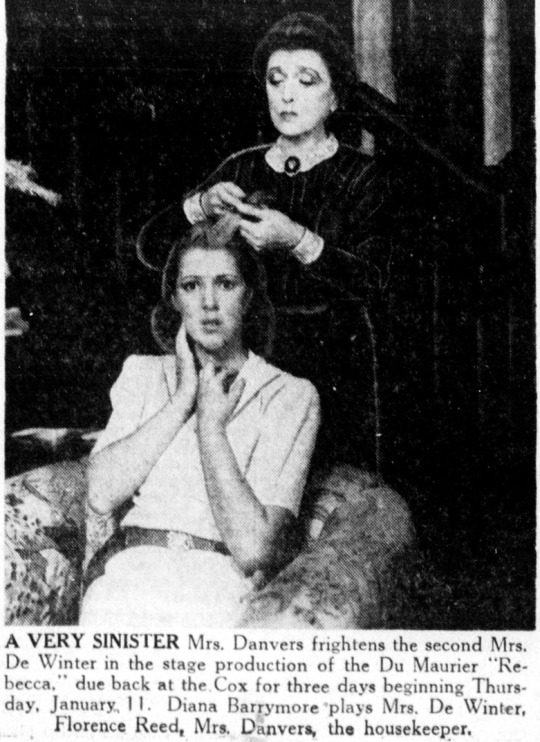
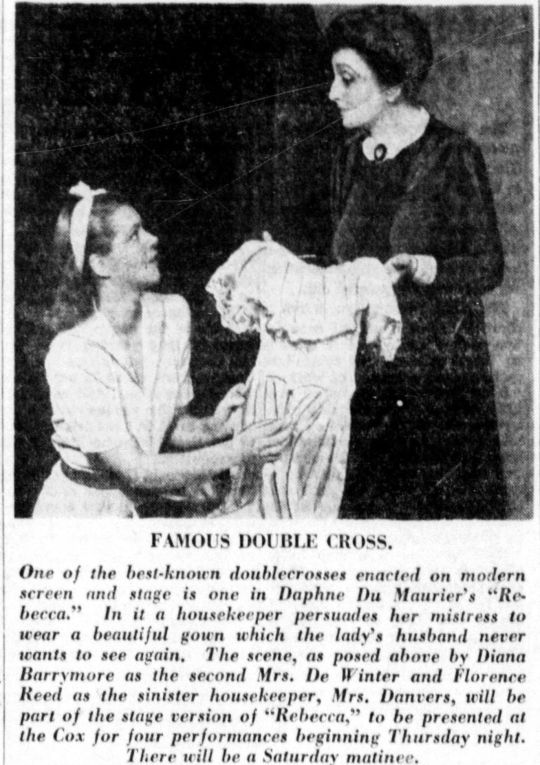


The next and last distinct adaptation of Rebecca to appear on stage before the musical was the 1983 opera production devised for Opera North, with music by Wilfred Josephs and libretto by Edward Marsh. It toured the UK before being revived briefly in 1988 and never seen again. Cast principals included: Ann Howard as Mrs Danvers, with Gillian Sullivan and later Anne Williams-King as the new Mrs de Winter, and Peter Knapp as Maxim.
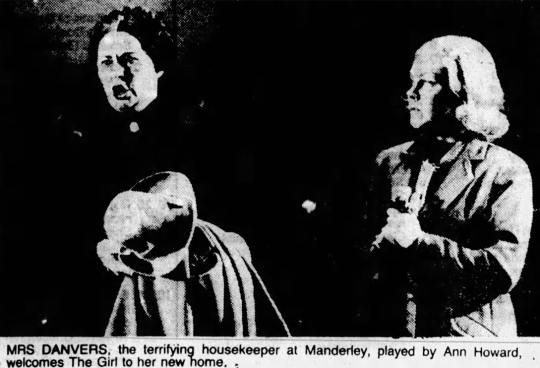
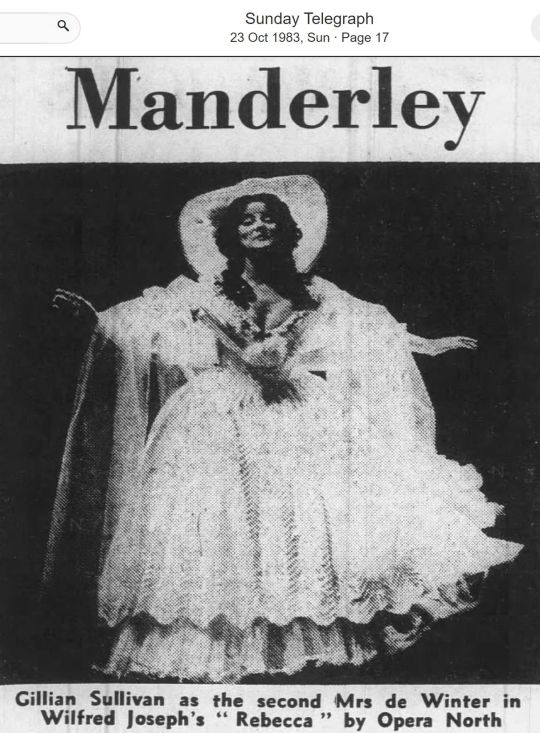
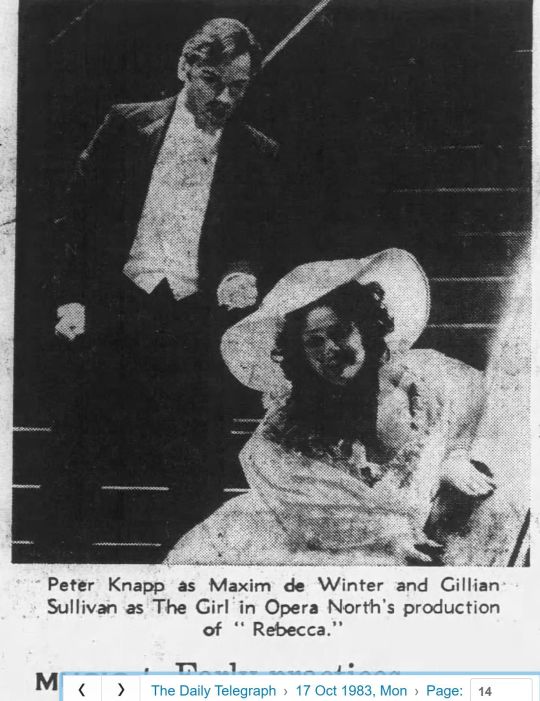
Finding these few, historic photographs in obscure newspapers or consulting original scripts and librettos, for instance, in libraries and archives during this effortful and active treasure-hunting felt special and rewarding. But possible reconstruction of these stage iterations in the present day is only incompletely possible, because of reduced ease of access to or apparent remaining visceral evidence of a visceral art form.
The frustration in trying to seek out these apparitional traces not only foregrounds the importance of maintaining accessible, comprehensive primary records within the theatre, but mirrors also the act of trying to seek out records of queer female sexuality across history in works of literature, cinema or theatre, as a process typified by a similarly effortful navigation of apparitional erasure. This facet connects with the notion that consideration around Rebecca entangles with a web of insatiability or dykeish dissatisfaction, a web that stretches from this erasure and liminality of representation, to character constructions within the work – including of its infamous housekeeper, Mrs Danvers, to contextual backgrounds like those of the story’s primary author itself, Daphne du Maurier.
The entity of Rebecca, then, across its many themes, productions and decades, is uniquely useful in the way it can in turn encompass and facilitate explorations of these many facets – being capable of simultaneously holding consideration of these expansive webs of documentation, erasure or dykeish dissatisfaction that can be found lurking in historical margins, as well as also the contrasting luminous energy that can be produced in the present in association with the musical, as physical audiences interact with and respond to the material of the show and its performers within theatres in real time. These considerations have transferrable applicability beyond this singular context of this particular show to more general notions of theatrical pieces and the practice of theatregoing, too, as they foreground the question of how audience members respond to, process, and interact with shows; and, as a matter of far less common discussion or scholarly writing on the subject of diva devotion, how female fans specifically navigate the complex predicament of queer, female, performance-driven high regard.
#rebecca the musical#rebecca das musical#rebecca#mrs danvers#ich#the new mrs de winter#daphne du maurier#lonbecca#rebecca london#kara lane#willemijn verkaik#musical theatre#musicals#terry castle#wayne koestenbaum#the apparitional lesbian#theatre
22 notes
·
View notes
Text
FICTIONAL CHARACTER ASK: EGON SPENGLER
Asked by @fleurviolettes
@janeb984
@spengnitzed @stantzed @bixiebeet @angelixgutz @thealmightyemprex @goodanswerfoxmonster @amalthea9 @themousefromfantasyland @professorlehnsherr-almashy @budcortfancam
Favorite Thing About Them: There was an excentric, always serious, socially awkward nerd character, played by a comedy actor who wasn't a big movie star like his screen colleagues Bill Murray, Dan Aykroyd, Sigourney Weaver and Rick Moranis were, originally only meant to provide technological exposition, and he became the breakout character that audiences most strongly cared about. Egon Spengler showed viewers that just because we wored glasses, weren't muscular or trained in complicated martial arts, it didn't mean we couldn't be seen as heroes, even tough he initially decided to capture ghosts just hoping to earn a living like his friends. Also, while ocasionally awkward and a bit shy around women, he is never shown to be self hating. He talks with certainty about his scientificial knowledge, isn't much bothered by the teasing of friends like the more street smart Peter Venkman and Winston Zeddemore, and is shown that is because of his inteligence and seriousness that Janine Melnitz finds him atractive, without Egon ever needing to try becoming more "tough", "atletic", "cool", etc.
His lines about humans being like small bacteria are even complimented as romantic! There were moments where he would show an explosive temper, but its clear that its only in extreme circunstances where a dangerous treat is on the horizon and everyone's emotions are heated, and not before trying to present argumentations to better solve the problem first.
Least Favorite Thing About Them: Returning to a criticism I made on this post here, when the writers of Afterlife, a sequel made 37 years after the original film, decided to incorporate Harold Ramis death as a major plot influence, they also mixed the complicated personal life fact that Ramis was an absent parent to his second daughter for most of her life, wich was something he deeply regreted, into the character of Egon Spengler, using the cliche plot of a father who abandons his daughter without explanation (not even letting his friends know of her existence because she is suposed to be a "big reveal" even in universe) to fight the great scope villain, and get redeemed in the eyes of sayed abandoned daughter just because he is dead. That is not character growth, that is not a tribute to his creator, thaf is just cynical, unecessary melodrama (ignoring that the first was a comedy!) exploiting a complicated, painfull story of an actual, real family.
Three Things I Have In Common With Them:
* I wear large glasses;
* Like his portrayal in the live action movies and IDW licensed comics, my natural hair is dark brown and grows in agitated curls;
* I love chocolate treats;
Three Things I Don’t Have In Common With Them:
* I don't collect spores, molds and fungus;
* I alternate between physical and online books, so I would never say the phrase "Print is dead";
* I'm not born in the United States;
Favorite Line:
From the July 1983 Script Draft:
"I don't understand. What have I got?"
"And not a very precise one."
"I have trace PKE valences everywhere in the building and extremely high readings in the interior stacks."
"Good in what sense?"
"I'm patched into the Bell Labs computer in Boston. We should have an answer in a moment."
"I think we can catch one."
"I own an automobile."
"It's a 1957 Saab."
"Those are proton packs and that's a Nutrona wand. They're prototypes of new devices for putting proto-mater in stasis."
"It's 9.642.55 square feet."
"Not all of this is for the office telephones. I'm constructing a fiberoptic network to monitor microwave activity outside the commercial frequencies assigned to telephone and television transmission."
"This is amusing."
"What?"
"I think it's too early to tell."
"We're all animals, Venkman."
"Okay - It's ready."
"This is the proton pack."
"14.55 kilos."
"Thirty-two pounds."
"This is the Neutrona wand."
"I'm working on a self-contained version but for now we'll run off building current."
"Switch... ON."
"It's ready."
"I've heat shielded the entire pack and it's fully portable now. We'll each be capable of shooting an ion stream up to 12 feet. The stream will repel ectoplasm but have no effect in the physical enviroment. Ready?"
"Power!"
"Then we'll be virtually defenseless."
"Ecto-visors."
"GIVE ME TWO PURGES NOW!!"
"Don't worry. He isn't going anywhere. Now DON'T LET THE STREAMS CROSS BEHIND THE POINT OF INTERSECTION OR YOU'LL Q US ALL INTO THE TENTH DIMENSION."
"Easy... easy... open the trap now!!"
"DON'T LET THE PHOTON STREAMS GET NEAR THE NUTRONA BARS ON THAT TRAP!!"
"Watch it... watch it... now."
"It's getting crowded in there. We have to arrange some kind of spill-release system."
"I tought we'd be busy but I never expected this many. That's what bothers me. All my recent data points to something big on the horizon."
"I am Egon Spengler, human being of Earth, Master of Physics, Doctor of Philosophy. Greetings Vinz Clortho."
"Free him, Officer. I will speak with the Minion of Gozer."
"I like these dehydrated meals because they save time. And they have a long shelf-life."
"Could I ask you a feel questions, Vinz?"
"Vinz, how will Gozer come?"
"I want you to look at these pictures, Vinz, and tell me if you see Gozer or anything that looks like Gozer."
"If I were to deactivate the grid generator, the facility could no longer contain the high-concentration of valences inside. You can see what's inside trough the monitor if you wish."
"I've plotted the location of our 99 confirmed manifestations. Look at the pattern and where it fits. Over the tri-state region we have many heavy industries responsible for the destruction of ozonic and other atmospheric layers. The random mesh of microwaves from telephone and telecomunication senders acts as a lens increasing the focus of all the sun's dangerous gamma and U.V. rays which otherwise would be filtered out if the protective atmospheric layers had not been destroyed. These rays are being focused raw on a region under which there lies buried many thousands of tons of chemical and radioactive waste releasing stripped electrons into the atmosphere.
Finally, even a casual glance at the map reveals this region lies within an almost equilateral triangle having at its intersecting points the Indian River Plant in New York here, the Three Mile Island Facility in Pensylvania here, and the Sands Creek Reactor here... two of which we know are leaking hundreds of roentgens per hour."
From the September 1983 Script Draft:
"Oh! This is big, Peter. This is very big. There's definitely something here."
"Two reasons. First of all, I found trace PKE valances everywhere in the building and extremely high readings in the interior stacks."
"That was both of them."
"Incredible. She was stripping ions all over the place."
"We were right about the proton count, Stantz."
"Raymond and I are convinced that we can trap a ghost and hold it indefinitely."
"Just for your information, Ray, the interest payments alone for the first five years come to over $75,000."
"Print is dead."
"Is that a game?"
"I collect spores, molds and fungus."
"I think it's the food of the future."
"This is the Proton Pack, Peter. The only problem with it at the moment is that it could cause sterility."
"Yes, well, I'm working on that."
"Peter, trust me. We are about to make scientific history."
"Raymond, the plug."
"She's telling the truth - or at least she thinks she is."
"Or even a race memory, stored in the collective unconscious. And I wouldn't rule out clairvoyance or telepathic contact either."
"You're a Scorpio with your moon in Leo and Aquarius rising."
"I blame myself."
"We'd better adjust our streams."
"Something was definitely here."
"Were you recently in the bathroom?"
"The wet towels, residual moisture on your lower limbs and hair, the redness in your cheeks indicating..."
"When you were in the bathroom, did you notice anything that was yellow and unusually smelly?"
"Wait! Wait! There's something I forgot to tell you."
"Don't cross the beams."
"Trust me. It will be bad."
"It's hard to explain, but try to imagine all life as you know it stopping instantaneously and finding yourself confined forever in another dimension."
"They're not guns. They're particle throwers."
"I couldn't do that. You might hurt someone."
"On Earth - no. But on Krypton we could slice him up like Oscar Mayer Bologna."
"Well, let's say this Twinkie represents the normal amount of psychokinetic energy in the New York area. According to this morning's PKE sample, the current level in the city would be a Twinkie 35 feet long weighing approximately six hundred pounds."
"I just met the Keymaster. He's here with me now."
"Die in what sense?"
"I don't care. I see us as tiny parts of a vast organism, like two bacteria living on a rotting speck of dust floating in an infinite void."
"You have nice clavicles."
"Oh, shit!"
"If you don't shut up I'm going to rip out your septum."
"Of course! Ivo Shandor. I saw his name in Tobin's Spirit Guide. He started a secret society in 1920."
"After the First World War, Shandor decided that society was too sick to survive. And he wasn't alone. He had close to a thousand followers when he died. They conducted rituals, bizarre rituals, intended to bring about the end of the world."
"Sumerian -- not Babylonian."
"I don't believe in luck."
"Thank you."
"It's Shandor - the architect!"
"I think he's saying that since we're about to be sacrificed anyway, we get to choose the form we want him to take."
"Full-stream with strogon pulse."
"No! Them! Shoot them! Cross the beams. Cross the beams."
From the 1984 movie final cut:
"That would have worked if you hadn't stopped me."
"Ray, it's moving. Come on."
"This is hot, Ray."
"Raymond, look at this."
"Venkman, get a sample of this."
"I'd like to analyze it."
"I'm getting stronger readings here. This way."
"I wouldn't say the experience wasn't completely wasted. According to these new readings, I think we have an excellent chance of actually catching a ghost and holding it indefinitely."
"I'm always serious."
"I think this building should be condemned. There's serious metal fatigue in all the load-bearing members. The wiring is substandard. It's completely inadequate for our power needs. And the neighborhood is like a demilitarized zone."
"I could look for the name Zuul in the usual literature."
"Tobin's Spirit Guide."
"Venkman, shorten your stream. I don't want my face burned off."
"I looked at the trap, Ray."
"I don't think he's human."
"Vinz, you said before you were waiting for a sign. What sign are you waiting for?"
"I think that would be extraordinarily dangerous."
"I'm warning you. Turning off these machines would be extremely hazardous."
"Try to understand. This is a high voltage laser containment system. Simply turning it off would be like dropping a bomb on the city."
"Clear the building!"
"Oh, come on!"
"Your mother!"
"The structure of this roof cap is exactly like the kind of telemetry tracker that NASA uses to identify dead pulsars in deep space."
"It's not the girl, Peter, it's the building. Something terrible is about the enter our world and this building is obviously the door."
"Forty years of darkness! Earthquakes! Volcanoes!"
"Art Deco. Very nice."
"It's Gozer."
"It's whatever it wants to be."
"Ray? This looks extraordinarily bad."
"Look out!"
"Sorry, Venkman. I'm terrified beyond the capacity for rational thought."
"I have a radical idea. The door swings both ways. We could reverse the particle flow through the gate."
"We'll cross the streams."
"Not necessarily. There's definitely a very slim chance we'll survive."
"I feel like the floor of a taxi cab."
"We'd like to get a sample of your brain tissue."
"Janine."
brOTP: His brother (Lionel in the novelization, Elon in the Earth Day TV Special), Eugene Visitor, Ray Stantz, Peter Venkman, Winston Zeddemore, Dana Barrett, Tiyah Clark, Slimer, Buster, Louis Tully, Sherman Tully, Dytyllio, Walter Peck, Louise, Irena Cortez, Bryan Welsh, Kylie Griffin, Eduardo Rivera, Garrett Miller, Roland Jackson, Ilyssa Selwin, Jenny Moran, Dani Shpak, Lou Kamaka, Marie Laveau.
OTP: Janine Melnitz.
nOTP: Pink Mood Slime, Gozer.
Random Headcanon: Since Egon still consults literature about the supernatural (more famously Tobin's Spirit Guide) and the STEM fields, is believable that when he says the phrase "Print is dead", is not in the sense that he doesn't read anything and only uses TV and radio as sources of information (otherwise he would have failed academically) but in the sense that his only reading is preexisting titles for work research and he doesn't read new releases and/or literary fiction and poetry, compared to Janine.
Unpopular Opinion: As I commented on this post here, I don't imagine that his parents (specially his father) were complete cold monsters that despised the concept of love when prioritizing Egon and his brother's academic education. Maybe some fans mix his father's personality with Uncle Cyrus, an old, demanding and arrogang relative that appeared in the Real Ghostbusters animated series, but its more interesting to imagine that, while flawed, Egon's parents were still feeling human beings who genuinelly loved him and his brother and just tought that working hard to provide them with a good school education while sacrificing spending time with the children was their, understandable tough misguided, way of showing how much they cared.
Songs I Associate With Them:
Medic
youtube
The Gods Are Not Crazy
youtube
She Blinded Me With Science
youtube
Weird Science
youtube
I Believe in You and Me
youtube
Just The Way You Are
youtube
Time in a Bottle
youtube
Favorite Picture of Them:
Harold Ramis in the 1984 film

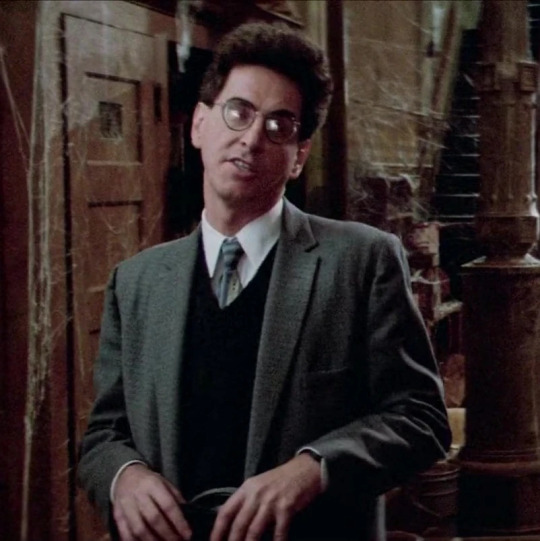
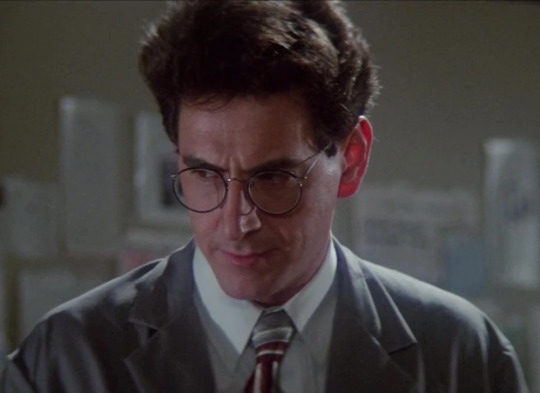


In the Real Ghostbusters animated series
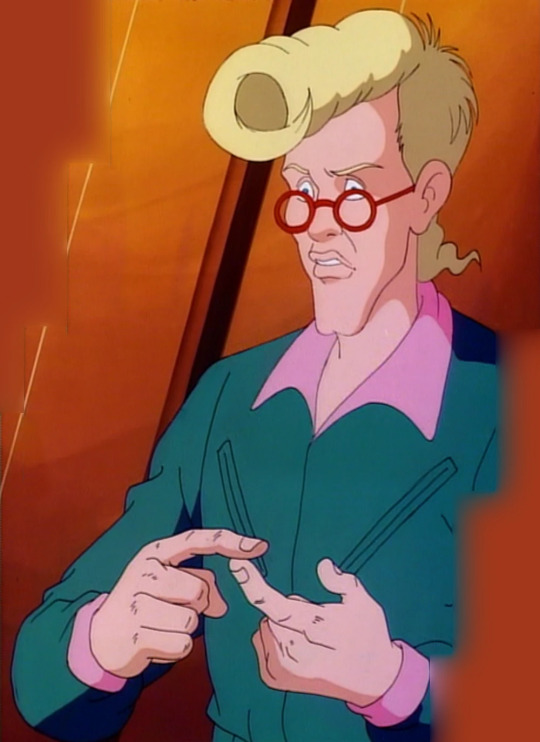
In the Extreme Ghostbusters animated series
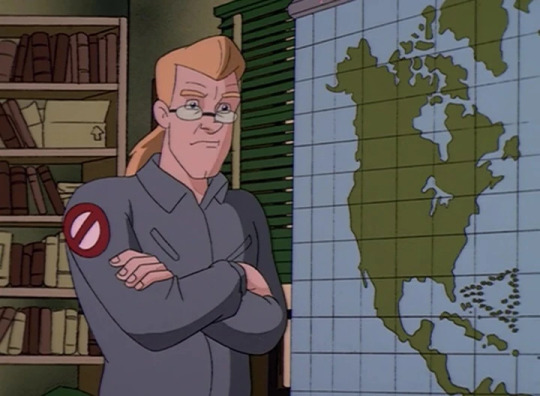
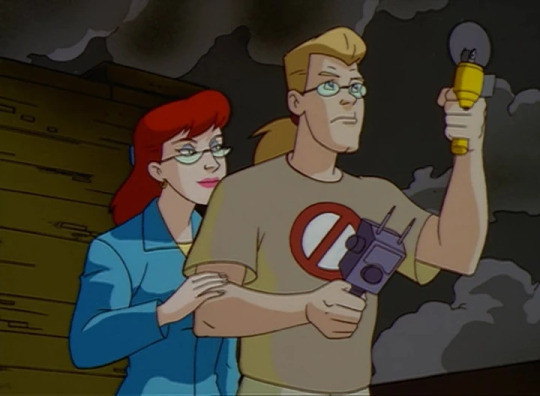
In the IDW licensed comics

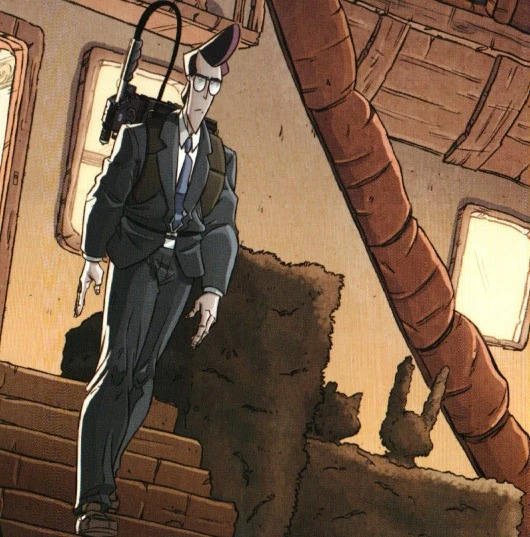
#fictional character ask#character ask meme#fleurviolettes#fandom musings#pop culture#ghostbusters 1984#the real ghostbusters#extreme ghostbusters#ghostbusters novelization#idw ghostbusters#harold ramis#maurice lamarche#egon spengler#Youtube
37 notes
·
View notes
Text
Huge list of album recommendations (continually updated)
Gille' Loves - 薔薇彩の吸血鬼 (Gothic rock, Visual kei)
Prefab Sprout - Swoon (sophistipop, indie pop)
SOS Band - Sands of Time (synthfunk, boogie, disco)
Happy Rhodes - Rhodes I (singer-songwriter, freak folk, prog)
David Sylvian - Brilliant Trees (art pop, singer songwriter)
Nelories - Mellow Yellow Fellow (Shibuya kei, indie pop)
The Kinbotes - S/t 1984 (lofi rock, indie rock, outsider music)
Dream Dolphin - Atmospheric Healing (ambient, new age, downtempo)
Muslimgauze - Mullah Said (tribal ambient, dub techno)
Antonio Vega - Oceano del Sol (alternative rock, singer songwriter)
Terry Allen - Juarez (outlaw country, alt country)
03 Greedo - Purple Summer (hip hop, cloud rap, trap)
Acetone - S/t (1997) (slowcore, alt country, indie rock)
Marine Timekeepers - A Perfect Knowledge of Dreams (dream pop)
Strawberry Switchblade - S/t (dream pop, synthpop)
Steve Hiett - Down on the Road by the Beach (Ambient rock, singer-songwriter, surf rock)
Jim O'Rourke - Simple Songs (indie rock, singer-songwriter)
Angel'in Heavy Syrup - IV (psychedelic rock, noise rock)
Maniac Mansion - Collection Plate (underground hip hop, outsider music)
Maria Kannon - Maria Kannon (1991) (psychedelic rock, garage rock)
Felt - Ignite the Seven Cannons (jangle pop, post punk)
Durrutti Column - LC (post punk, dream pop)
The Chameleons - Script of the Bridge (post punk, gothic rock)
Laughing Clowns - Ghosts of an Idea (post punk)
Kan Mikami - Mikami Kan no Sekai (singer-songwriter, avant folk, enka)
Todd Edwards - Prima Edizione (UK garage, garage house)
Pictures - Pictures (1983) (art pop, experimental)
Johnny "Guitar" Watson - I Don't Want to Be Alone, Stranger (Funk, soul)
The Orb - Orbus Terrarum (ambient, downtempo, sound collage)
Annie - Anniemal (Electropop, dance pop)
Mandy More (with one 'o', not Mandy Moore) - But That is Me (singer-singer-songwriter, folk, psychedelic pop)
Ka - The Thief Next to Jesus (concious hip hop, abstract hip hop)
Todd Rundgren - Something / Anything (psychedelic rock, pop, singer-songwriter)
Djavan - S/t (1989) (MPB, sophistipop)
A Forest Called Mulu - A Search for the Unexplored (trance, downtempo, trip hop)
Strange Boutique - The Loved One (dream pop)
Gigi Masin - Wind (ambient)
Main Attrakionz - 808s & Dark Grapes II (cloud rap)
Revolutionary Army of the Infant Jesus - The Gift of Tears (psychedelic folk, avant folk)
Bear Garden - I am a Gardener (singer-songwriter, indie pop, electronic)
The Wake - Here Comes Everybody (dream pop, jangle pop)
Negativland - Escape the Noise (plunderphonics, sound collage)
Mike Oldfield - On Hergest Ridge (new age, ambient folk, celtic)
High Tide - Sea Shanties (heavy psych, prog rock)
Bigg Jus - The Black Mamba Syrums pt. 1 (experimental hip hop, concious hip hop, turntablism)
Tales of Terror - S/t 1984 (Hardcore punk, horror punk)
Chrome - Alien Soundtracks (Experimental rock, post punk, noise rock)
Cressida - Asylum (psychedelic rock, prog rock)
Telex - Wonderful World (synth pop, electro)
Sophie & Peter Johnston - S/t 1987 (synthpop, singer-songwriter, new wave)
Exposé - Exposure (freestyle, pop)
ILoveMakonnen - Drink More Water 3 (hip hop, singer songwriter)
Sequentia - Canticles of Ecstasy (classical music, gregorian chant)
Harry Case - In a Mood (synthfunk)
2 notes
·
View notes
Text
☆ my current list of DRs that if scripted/half scripted ☆
The Outsiders (1983)
The lost boys (1987)
X-men/ 2000s
Better CR
IT (1990)
1980s
The umbrella academy
#shifting antis dni#shifting realities#shifting#shifting community#I seriously can’t stop making them. HELP
1 note
·
View note
Text
Mississippi Masala: The Ocean of Comings and Goings
By Bilal Qureshi MAY 25, 2022
often remark that my Punjabi parents immigrated to the American South woefully unaware that they’d brought us to a place with an incurable preexisting condition. Racism doesn’t belong exclusively to the South—the former Confederacy—but it was implemented at industrial scale across the region’s economic, political, and cultural life. Alongside this landscape’s sublime natural beauty—rivers, fields, and bayous—sits the history of America’s unsparing brutality against its Black citizens. On the other side of the world, in South Asia, as well as among its global diasporas, anti-Blackness is embedded in ideas of colorism and caste, in tribal imaginaries and policed lines of “suitable” marriages.
The possibility to live—and to love—across racial borders is the theme of Mira Nair’s extraordinarily prescient and sexy second feature film, Mississippi Masala (1991). Three decades later, it speaks to a new generation as groundbreaking filmic heritage—but also with an almost eerie, prophetic wisdom for how to live beyond the confinements of identity and color. Even by today’s standards, the film is a radical triumph of cinematic representation, centering as it does Black and Brown filmmaking, acting, and storytelling. It is also a genre-defying outlier that would likely be as difficult to get financed and produced today as it was then. Part comedy, part drama, rooted in memoir and colonial history, the film that Nair imagined was a low-budget independent one with global settings and ambitions. The notion of representation—perhaps more accurately described as a correction of earlier misrepresentations—wasn’t its point or its currency. Race was its very subject. Nair has said she wanted to confront the “hierarchy of color” in America, India, and East Africa with the film—the kinds of limitations that she had experienced firsthand by living, studying (first sociology, then film), and making documentaries in both India and the United States. In a shift that began with her first feature film, Salaam Bombay! (1988), Nair set out to transform those real-world issues into fictionalized worlds, translating her sociological observations into works suffused with beauty, music, and, in the case of Mississippi Masala, humid sensuality.

Nair first engaged with the questions at the heart of the film when she came to the United States from India to study at Harvard in the mid-1970s. As a new arrival to the country’s color line, she has recalled, both its Black and white communities were accessible to her, and yet she belonged to neither. The experience of being outside that specific American binary would be a formative and fertile site of dislocation for the young filmmaker. Nair trained in documentary under the mentorship of D. A. Pennebaker, among others, and her first films were immersive explorations of questions that haunted her own life. The pangs of exile and homesickness for lost motherlands became the foundation of So Far from India (1983), and the boundaries of “respectability” for women in Indian society the subject of India Cabaret (1985). Salaam Bombay!—made in collaboration with her fellow Indian-born classmate, the photographer and screenwriter Sooni Taraporevala—carried her Direct Cinema training to extraordinary new heights. Working, from a script by Taraporevala, with nonactors on location in the streets of Mumbai, Nair found a filmic language that could merge the rigor of realism with the haunting emotion of fiction. It would become the creative model for Nair and Taraporevala’s translation of the real-life phenomenon of Indian-owned motels in the American South into a spicy cinematic blend of migration, rebellion, and romance.
During research trips across Mississippi, Louisiana, and South Carolina that Nair made in 1989, she discovered that many of the Indian motel owners in the South had come to the United States from Uganda following their expulsion by President Idi Amin in 1972. Ten years after the East African country gained its independence from British rule, Amin had blamed his country’s economic woes on its privileged and financially successful South Asian community. In the racial politics of empire, the British had privileged the Indian workers they had imported to East Africa, creating racial hierarchies Amin now wanted to destroy by way of politicizing race anew. In a line that is repeated in the screenplay, the mission was “Africa for Africans,” and for tens of thousands of Asian families, it was an uprooting and dislocation from which some would never recover.
In Mississippi Masala, the classically trained British Indian actor Roshan Seth plays Jay, the immigrant father who is the focal point of the “past” of the film’s dual narrative, which is beautifully balanced in the way that it interweaves the perspectives of two generations. In the film’s harrowing overture, Jay—along with his wife, Kinnu (Sharmila Tagore), and their daughter, Mina (Sarita Choudhury)—is being forced to flee Kampala, and he laments that it will always be the only home he has known. With stoic reserve, holding back tears, Seth conveys the gravity of the loss, as the camera captures the lush beauty of the family’s garden and the faces of those they must leave behind. Throughout the film, as Kinnu, Tagore—an acclaimed Indian film star and frequent Satyajit Ray collaborator—is a composed counterpoint to Seth’s troubled Jay in her character’s strength and resilience. When the film picks up with the family two decades later, Kinnu is shown managing the family’s liquor store, while an aging Jay writes to petition Uganda’s new government to reclaim his lost property. Nair’s camera pans up from his writing desk to reveal through his window the parking lot of a roadside Mississippi motel. This is where Jay works and exists in a permanent state of nostalgia, until he is jolted awake by Mina’s demands for a home and a life of her own.

Even as Jay dreams in sepia-toned memories, the film itself never descends into saccharine longing or scored sentimentality. The rigor of the research and on-location filmmaking in both Mississippi and Kampala is reflected in an unvarnished and immersive visual style. While Nair herself clearly understood the fabric of the lives of the Gujarati Hindu families she was portraying, she has discussed how Denzel Washington became a critical collaborator in ensuring that southern Black life was rendered with equal attention to detail, cultural specificity, and dignity. The result is a film whose homes and communities are etched with a palpable sense of reality.
All of Mississippi Masala’s disparate threads are bound together by a distinctly sultry southern love story, which naturally remains the best-remembered feature of the film. The meet-cute of Mina and Washington’s character, Demetrius, is quite literally a traffic collision, a not-so-subtle suggestion that, without a bit of movie magic and melodrama, these two southerners might never have been maneuvered into the exchanged numbers and glances, and palpable wanting, that still burn the screen today. The film is fueled by the gorgeousness and megawatt charisma of both its stars, the young Washington paired with Choudhury in a prodigious debut as a woman at the edge of adulthood—her mane of wavy hair, their sweaty night of dancing to Keith Sweat, aimless late-night phone calls, dark skin in white bedsheets, secret meetings, consummated desires.
In the background of the R&B song of young, electric love are the film’s quieter, deeper notes on migration. A string leitmotif by the classical Indian violinist L. Subramaniam recurs whenever the vistas of Lake Victoria across the family’s lost garden in Kampala appear on-screen in brief flashbacks. Nair’s mastery with music has only deepened with time, resulting in films that integrate archival and original music with a free-form alertness that is distinctly her own. Both for the African American people living amid strip malls in the dilapidated neighborhoods of a region to which their ancestors were brought by bondage, and for the Indian families forced by Amin to flee their homes, exile is expressed in stereo. As Jay pines for the country he lost, Demetrius’s brother dreams of visiting Africa and saluting Nelson Mandela—disparate but recognizable longings and family histories shared over a southern barbecue, American bridges.

There wouldn’t be racial borders, however, if they weren’t policed, and the policing authorities here come from across the racial spectrum. When Mina and Demetrius’s relationship is discovered by nosy Indian uncles, those boundaries flare up. From the Black ex-girlfriend who asks why the good Black men can’t date Black women, to the Indian uncles who barge into Demetrius and Mina’s hotel room, to the gossiping aunties who during phone calls mock Mina’s rebellious scandal, there is a veritable chorus of condemnation. It is portrayed with great comedic timing and wit, including from Nair herself, who delivers some of the sharpest lines of disapproval in the role of “Gossip 1.” But the implications of those judgments remain unfunny by design. The film’s remarkable achievement is the way it never buckles under the thematic weight of these uncomfortable truths. Nair always delivers her cerebral punches with a lightness and warmth that are precisely calibrated. These are the markers of a filmmaker in full control of the tone, color, production design, and, always, music to accompany the emotional demands of her material, and that facility has only gotten sharper in such masterpieces as Monsoon Wedding (2001).
Mississippi Masala showed at festivals in late 1991 and was released commercially in American cinemas in February 1992, within weeks of Wayne’s World and Basic Instinct. Working outside Hollywood’s conventions, Nair joined an extraordinary flowering in independent filmmaking that continues to be celebrated. The year 1991 had been a landmark one for Black cinema already, with the release of Julie Dash’s Daughters of the Dust, Mario Van Peebles’s New Jack City, and John Singleton’s Boyz n the Hood. Spike Lee’s opus Malcolm X, with Washington in the title role, would be released in the U.S. in late 1992. Nair’s film was shown at the same 1992 Sundance Film Festival at which a landmark panel about LGBTQ representation heralded a movement, named New Queer Cinema by moderator B. Ruby Rich, devoted to reclaiming stories of love and suffering from Hollywood’s gaze. These were parallel currents that echoed larger shifts and openings happening in global culture. The collapse of the Soviet Union, the end of apartheid in South Africa, India’s economic liberalization, and the rise of a youthful southern Democrat in the U.S. following a decade of Republican rule were stirrings of a new order. The possibilities were being felt all over the world as Nair’s film of southern futures arrived. Described by the New York Times at the time as “sweetly pungent” and by the Washington Post as a “savory multiracial stew,” Mississippi Masala opened in American cinemas to rave, if exoticizing, reviews, less than a decade after Richard Attenborough’s Gandhi and Steven Spielberg’s portrayal of Indian characters eating monkey brains during a ritual dinner in Indiana Jones and the Temple of Doom. Realistic international cinema featuring everyday South Asian life—as opposed to the Indian musical tradition or Hollywood’s tropes about foreignness—had almost no precedents or peers at the time. The depiction of South Asian characters as ordinary working-class Americans navigating questions of family, money, and love remains a radical achievement. Mississippi Masala also manages to decenter whiteness altogether. In a film about racial hierarchies, white characters appear only in the background, as the motel guests, patrons, and shopkeepers of Greenwood society. By design, this is first and foremost a film about Mina and Demetrius, and the families and communities that formed them. Despite all the extraordinary accomplishments in the streaming age by the current generation of filmmakers of color, Mississippi Masala’s layered portrayal of race and love still feels unparalleled. To hear its characters speak candidly about the real lines that divide them, and reflect on the costs of crossing those lines, is to recognize the rigorous thinking—and living—that informed the screenplay. Even more disappointing than the lack of contemporary equals to the film, perhaps, are the offscreen parallels in South Asian communities like my own, where colorism and anti-Blackness are stubborn traditions yet to be fully dismantled. Stories of interracial love are still rarely told on-screen, and these relationships—the masala mixes—are still not visible enough to become as normalized as they deserve to be.
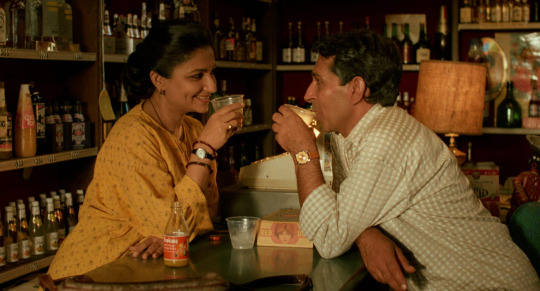
One of Nair’s first films, So Far from India, was filmed between New York City and Gujarat. It opens with a folk musician in the streets of Ahmedabad, a sequence that serves as a prelude to the film, about an Indian immigrant and the wife he has left behind. Nair, as narrator, translates his singing about the ocean of comings and goings. With Mississippi Masala, Nair positioned herself as both a great chronicler and a great navigator of that vast ocean of comings and goings. America is one of Nair’s homes, and she has made several films about the immigrant experience there, including her adaptations of Jhumpa Lahiri’s The Namesake (2006) and Mohsin Hamid’s The Reluctant Fundamentalist (2012). Each has sought to look at the country through the eyes of those usually on the margins in order to dramatize and problematize the idea of the American dream. It is these poetic and cinematic ruminations on identities in flux that feel like her most enduring, almost personal, gifts to hyphenated viewers like myself.
When I was younger, I thought Mississippi Masala embodied Mina’s rebellion, the promise of independence, and the freedom to choose whom and how to love. But now, twenty years after I first saw the film, at university, Jay’s longing for home and his incurable displacement feel equally, achingly resonant. With the limitations of America laid bare by the gift of adulthood, migration is no longer only a hurtling forward toward the rush of freedoms; it is now also the unknowable costs borne by my parents, the homes and selves they left behind.
The film’s closing credits, braiding Jay’s return to Kampala with glimpses of Mina and Demetrius kissing in the warmth of the southern sun, capture Nair’s exquisite feat of balancing—and blending—in Mississippi Masala. For a film traversing so many geographies and registers, there is finally a seamless harmony between father and daughter, between tradition and future, between here and there. As seen anew in restored colors, Mississippi Masala endures not for its spicy and pungent aromas of cultural specificity or representational breakthrough but for this profound commitment to multiplicity. It is a timeless song for and to those who live—and love—in multitudes.

#Criterion Collection#Mississippi Masala#Mira Nair#Charles S. Dutton#Denzel Washington#Roshan Seth#Sarita Choudhury#Sharmila Tagore#Joe Seneca#Bilal Qureshi
6 notes
·
View notes
Text
youtube
Happy 65th birthday to Derek William Dick, better known as Fish, frontman with the group Marillion.
Fish was born on April 25th 1958 in Dalkeith, first born son of Robert And Isabella Dick. His parents ran a garage and petrol station, where he worked as a pump attendant in his youth. He has a sister, Laura, 3 years his junior. He attended Kings Park Primary School and Dalkeith High School, in his childhood home town, just outside Edinburgh.. He left school; with grade A O-levels in History, Chemistry, English, Maths and Biology and grade B O-levels in German and English Literature.
In 1976 he started to work as Forester. In 1980 he quit and started a musical career. He joined a band called Blewitt and joined Marillion in 1981. After a year of intense gigging in the UK they got signed to EMI and released their debut album Script for a Jester’s Tear in 1983.
Their biggest hit singles were Kayleigh and Lavender in 1985 (from the number one album Misplaced Childhood and Incommunicado in 1987. Their other top 40 singles included Garden Party, Sugar Mice and Warm Wet Circles. In 1988, after touring their critically acclaimed fourth album Clutching at Straws he left the band to start a solo career
In 1987 he married Tamara, a model from Berlin who he had met during the recording of the album Misplaced Childhood and who appears in the music video of “Kayleigh”. Later she also appeared in the video of his solo single, A Gentlemen’s Excuse Me. They have a daughter, Tara Rowena Dick, born on January 1st, 1991. In 2001 Fish and Tamara separated.
Derek has also tried his hand at acting his first job was in Zorro, and he isn’t shy of having a bit of fun in his roles, playing “Derek Trout”, a record producer in the 1999 series A young person’s guide to becoming a rockstar.
The East Lothian-based singer has undergone spinal and shoulder surgery and suffered two bouts of potentially deadly sepsis.
In 2020 Derek released an album called Weltschmerz, and it gave Fish a surprise hit , but not a chart hit, his management say it would have been number two in the UK charts, well done big man! The album was entirely self-funded, marketed, created and distributed from his home in Scotland and because UK chart rules require distribution through official channels it was precluded from the official charts.
Fish also revealed in that 2020 he’s retiring from the music business — saying: “I don’t want to be 70 and singing Kayleigh on the chicken-in-a-basket circuit While I can’t see him doing the likes of Rewind, I would think he will still be releasing material given the success of Weltschmerz, it sold over 60, 000 copies.
Fish did tour Weltschmerz and celebrated the 30th anniversary of A Vigil In A Wilderness of Mirrors as part of the Vigil's End tour in 2021. The tour was documented on the live album Vigil's End Tour 2021, released on physical formats in December 2022 and digitally in March 2023.
Derek has filled stadiums and sold thousands of records around the world - but he is now preparing for the quiet life in the Outer Hebrides after visiting last year.
The musician has snapped up a 35-acre croft on Berneray with his wife Simone.
A recent report says a planning application has been lodged to carry out renovations at the couple's new home at Beasdaire, which overlooks a beach at the northerly end of the island. Dick, currently lives in East Lothian and told his fans during an online broadcast earlier this month the prospect of relocating to the islands was 'really exciting'.
The former rock star is a keen gardener and host of the award-winning Fish on Friday - a Facebook live-stream. On the move he says been watching programmes about farming on the islands and held Gaelic, which is spoken widely on Berneray, in high regard.
More details about Derek on his web page here https://fishmusic.scot/
7 notes
·
View notes
Photo
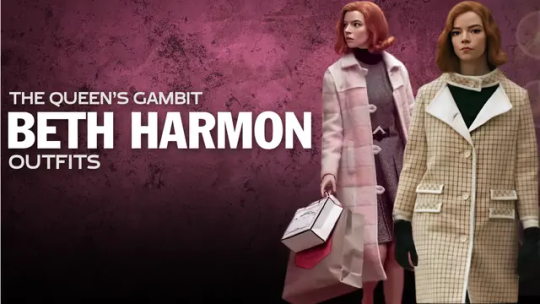
Distributed by Netflix, The Queen’s Gambit came and smashed the records like no other. The coming-of-age period drama was Netflix’s most-watched scripted series within the four weeks of its release. Starring Anya Taylor-Joy as lead character Beth Harmon, the series was based on the novel of the same name written in 1983 by Walter Tevis. The series followed the life of Beth Harmon who is an orphan but grows to become a chess prodigy. She struggles with drug and alcohol dependency as her journey continues. Apart from the cinematography, picturization, and performance, Beth Harmon outfits grabbed the attention of the audience. Also, each outfit that Anya wore in the series looked stunning on her and showed her personality to be quite balanced! On the other note, the series increased the public interest in chess which was pretty evident seeing the performances and storyline. While the popularity of the show made Anya an overnight star, her outfits stole the hearts of women. Her wardrobe became an instant search on the internet. Therefore, The Queen’s Gambit Beth Harmon coats and jackets became super popular among the general masses. At New American Jackets, we observed the trends and searches where Beth Harmon outfits beated the rest. So, we decided to launch a collection for our customers who are fans of Anya Taylor-Joy’s Beth character. Also, the prices are quite reasonable so you can easily shop the imitated garments without straining your budget. Our Top-Selling Pieces From The Queen’s Gambit Beth Harmon Wardrobe The Queen’s Gambit is one of those miniseries that have depicted the real game of chess with perfect accuracy. While balancing the game’s reliability, the series incredibly showcased the lead actress in her avatar. From performance to dialogue delivery, everything peaked! And just like that, The Queen’s Gambit Beth Harmon Clothing also made the waves. We have crafted a few of the garments from the series for our stunning ladies. Check out the pieces from the collection today and place the order for yours now! The Classic & Elegant Women’s Vintage Maroon Wool Overcoat Anya as Beth Harmon inspired all fashion-forward women across the globe. Her dresses throughout the series complemented her personality and prodigy. Each garment that she wore in the series promised practicality and comfort. Taking inspiration from one of her garbs, we have crafted this wonderful women’s vintage maroon wool overcoat. This overcoat has a very bold and sophisticated charm to help you attain an iconic look. Therefore, we recommend you purchase this truly beautiful overcoat and showcase the smarter side of your personality. About the Features This stunning overcoat is manufactured with wool fabric and is lined with the viscose material. The combination of both the fabrics make this fit super soft and warm for the wearer. Over the front, it has a buttoned style closure which adds more sleekness to the fit. A magnificent lapel style collar is also designed to provide a perfect frame around the neck and shoulders. Also, to help you keep your essentials safe and secure, we have added two outside and one inside pocket in this coat. Styling Tips This maroon coat is one of our top-selling items from The Queen’s Gambit Beth Harmon coats collection. It has a very smart and sharp appeal making it an instant catch for you. You can style this coat in the following ways. Wear this coat over white buttoned shirt and pair it with denim jeans for a casual outgoing look. For a professional touch, style the coat with beige dress pants and cream colored dress shirt along with ankle boots. The Wonderful Cream Beige Houndstooth Long Wool Coat Beth Harmon has been shown as a chess prodigy in the series. Her growth as a protagonist from childhood to adulthood has been picturized remarkably. From powerful makeup to majestic looks, Anya Taylor-Joy has played the character like it was made for her! In one of the scenes, she is seen wearing a warm and classy beige colored checkered coat. So, we decided to craft this one for our collection. This Cream Beige Houndstooth Long Wool Coat is minimal yet attractive at the same time. Thus, buying this garb at reasonable prices should be on your list! About the Features To manufacture this astoundingly perfect coat from our Beth Harmon outfits collection, we have used wool fabric on the external side. For the lining purpose, viscose fabric has played its role. The buttoned closure on the front with wool outline makes the checkered design pop a little more. Further features of the coat include lapel style collar with buttoned strapline. While keeping up with the functionality of the garb, we have added two outside and one inside pocket in this coat. This way, all your belongings will stay safe and secure. Styling Tips Beige color itself is very minimal and calm. It makes your personality appear mature and confident. The same goes with this garment as it looks versatile and pairs with so many basic clothing items. You may wear it in the mentioned ways. You may carry this coat over black leggings and black ribbed top on the inside. Accessorize the look with black gloves and you are all set for a date look. To keep it everyday casual, pair the coat with light rinse denim jeans and white t-shirt on the inside. The Eye-Grabbing Vintage Pink Plaid Wool Coat For Women The way Anya Taylor-Joy portrayed the character of Beth Harmon in the series shows how confident and empowered she was while doing the series. Her breathtaking screen presence captivated the viewer’s mind and heart for a long time. Also, her clothing left a positive impression on fashion-forward people. She was seen wearing a pink coat in the series so we decided to add it in the collection too! This Vintage Pink Plaid Wool Coat For Women promises durability and comfort for the wearer. So, this is definitely a must-have for your wardrobe for the upcoming winters. About the Features This showstopper coat features the wool fabric on the external side. On the inside, it has a viscose lining. So, it is safe to say that the coat is truly extraordinary and warm to wear. Furthemore, the coat features loop-buttoned closure on the front which guarantees a snug fit. It also has a shirt style collar along with two outside and one inside pocket. Thus, your style and practicality won’t be compromised at all. Also, you will find full-length sleeves in this coat providing an additional layer of protection. Styling Tips For the women who love to dress up in style while staying all toasty, this coat serves as an ideal pick for them. Due to its subtle color hues, this coat is quite versatile to pair with as many clothing items as you like. We have mentioned two styling tips for you! If you love to wear mini and tea length midi dresses in winters, this coat will play a crucial role to add a layer of warmth and elegance to your outfit. You can carry this dress to a get-together and winter party too. Pair it up with a sleek turtleneck and fitting jeans to look stunner! Parting Shot In Queen Gambit’s Style! Anya Taylor-Joy or if we call her by her character name Beth Harmon (it won’t be wrong either) has truly sent a wave of fashion across the industry. Women who love to dress elegantly and confidently have showered her with recognition and compliments. This Beth Harmon outfits collection at New American Jackets has got you all the pieces that you wish to steal from the series wardrobe. So, visit the store now and acquire the stunning coat of your choice at the reasonable prices. Source link
0 notes
Photo
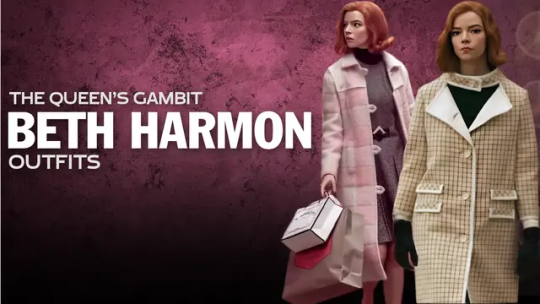
Distributed by Netflix, The Queen’s Gambit came and smashed the records like no other. The coming-of-age period drama was Netflix’s most-watched scripted series within the four weeks of its release. Starring Anya Taylor-Joy as lead character Beth Harmon, the series was based on the novel of the same name written in 1983 by Walter Tevis. The series followed the life of Beth Harmon who is an orphan but grows to become a chess prodigy. She struggles with drug and alcohol dependency as her journey continues. Apart from the cinematography, picturization, and performance, Beth Harmon outfits grabbed the attention of the audience. Also, each outfit that Anya wore in the series looked stunning on her and showed her personality to be quite balanced! On the other note, the series increased the public interest in chess which was pretty evident seeing the performances and storyline. While the popularity of the show made Anya an overnight star, her outfits stole the hearts of women. Her wardrobe became an instant search on the internet. Therefore, The Queen’s Gambit Beth Harmon coats and jackets became super popular among the general masses. At New American Jackets, we observed the trends and searches where Beth Harmon outfits beated the rest. So, we decided to launch a collection for our customers who are fans of Anya Taylor-Joy’s Beth character. Also, the prices are quite reasonable so you can easily shop the imitated garments without straining your budget. Our Top-Selling Pieces From The Queen’s Gambit Beth Harmon Wardrobe The Queen’s Gambit is one of those miniseries that have depicted the real game of chess with perfect accuracy. While balancing the game’s reliability, the series incredibly showcased the lead actress in her avatar. From performance to dialogue delivery, everything peaked! And just like that, The Queen’s Gambit Beth Harmon Clothing also made the waves. We have crafted a few of the garments from the series for our stunning ladies. Check out the pieces from the collection today and place the order for yours now! The Classic & Elegant Women’s Vintage Maroon Wool Overcoat Anya as Beth Harmon inspired all fashion-forward women across the globe. Her dresses throughout the series complemented her personality and prodigy. Each garment that she wore in the series promised practicality and comfort. Taking inspiration from one of her garbs, we have crafted this wonderful women’s vintage maroon wool overcoat. This overcoat has a very bold and sophisticated charm to help you attain an iconic look. Therefore, we recommend you purchase this truly beautiful overcoat and showcase the smarter side of your personality. About the Features This stunning overcoat is manufactured with wool fabric and is lined with the viscose material. The combination of both the fabrics make this fit super soft and warm for the wearer. Over the front, it has a buttoned style closure which adds more sleekness to the fit. A magnificent lapel style collar is also designed to provide a perfect frame around the neck and shoulders. Also, to help you keep your essentials safe and secure, we have added two outside and one inside pocket in this coat. Styling Tips This maroon coat is one of our top-selling items from The Queen’s Gambit Beth Harmon coats collection. It has a very smart and sharp appeal making it an instant catch for you. You can style this coat in the following ways. Wear this coat over white buttoned shirt and pair it with denim jeans for a casual outgoing look. For a professional touch, style the coat with beige dress pants and cream colored dress shirt along with ankle boots. The Wonderful Cream Beige Houndstooth Long Wool Coat Beth Harmon has been shown as a chess prodigy in the series. Her growth as a protagonist from childhood to adulthood has been picturized remarkably. From powerful makeup to majestic looks, Anya Taylor-Joy has played the character like it was made for her! In one of the scenes, she is seen wearing a warm and classy beige colored checkered coat. So, we decided to craft this one for our collection. This Cream Beige Houndstooth Long Wool Coat is minimal yet attractive at the same time. Thus, buying this garb at reasonable prices should be on your list! About the Features To manufacture this astoundingly perfect coat from our Beth Harmon outfits collection, we have used wool fabric on the external side. For the lining purpose, viscose fabric has played its role. The buttoned closure on the front with wool outline makes the checkered design pop a little more. Further features of the coat include lapel style collar with buttoned strapline. While keeping up with the functionality of the garb, we have added two outside and one inside pocket in this coat. This way, all your belongings will stay safe and secure. Styling Tips Beige color itself is very minimal and calm. It makes your personality appear mature and confident. The same goes with this garment as it looks versatile and pairs with so many basic clothing items. You may wear it in the mentioned ways. You may carry this coat over black leggings and black ribbed top on the inside. Accessorize the look with black gloves and you are all set for a date look. To keep it everyday casual, pair the coat with light rinse denim jeans and white t-shirt on the inside. The Eye-Grabbing Vintage Pink Plaid Wool Coat For Women The way Anya Taylor-Joy portrayed the character of Beth Harmon in the series shows how confident and empowered she was while doing the series. Her breathtaking screen presence captivated the viewer’s mind and heart for a long time. Also, her clothing left a positive impression on fashion-forward people. She was seen wearing a pink coat in the series so we decided to add it in the collection too! This Vintage Pink Plaid Wool Coat For Women promises durability and comfort for the wearer. So, this is definitely a must-have for your wardrobe for the upcoming winters. About the Features This showstopper coat features the wool fabric on the external side. On the inside, it has a viscose lining. So, it is safe to say that the coat is truly extraordinary and warm to wear. Furthemore, the coat features loop-buttoned closure on the front which guarantees a snug fit. It also has a shirt style collar along with two outside and one inside pocket. Thus, your style and practicality won’t be compromised at all. Also, you will find full-length sleeves in this coat providing an additional layer of protection. Styling Tips For the women who love to dress up in style while staying all toasty, this coat serves as an ideal pick for them. Due to its subtle color hues, this coat is quite versatile to pair with as many clothing items as you like. We have mentioned two styling tips for you! If you love to wear mini and tea length midi dresses in winters, this coat will play a crucial role to add a layer of warmth and elegance to your outfit. You can carry this dress to a get-together and winter party too. Pair it up with a sleek turtleneck and fitting jeans to look stunner! Parting Shot In Queen Gambit’s Style! Anya Taylor-Joy or if we call her by her character name Beth Harmon (it won’t be wrong either) has truly sent a wave of fashion across the industry. Women who love to dress elegantly and confidently have showered her with recognition and compliments. This Beth Harmon outfits collection at New American Jackets has got you all the pieces that you wish to steal from the series wardrobe. So, visit the store now and acquire the stunning coat of your choice at the reasonable prices. Source link
0 notes